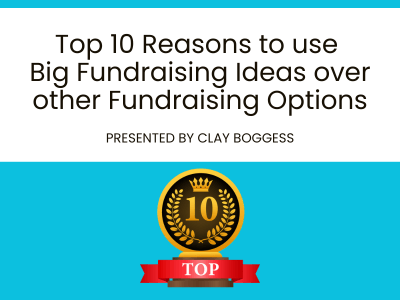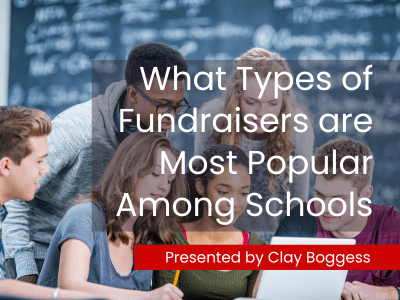
Common frustrations schools have with prize programs.
Almost everyone who's witnessed a catalog fundraiser kickoff assembly at an elementary school can see how excited students get once they see the prizes. Their initial response is usually one of great optimism and anticipation. Everyone thinks they can win the biggest and best prize. Most leave excited, ready, and eager to go out and make sales.
However, frustration and discouragement set in once they start selling and fully comprehend how many items they must sell to win the desirable prizes. The way that most prize programs work is that low-quality prizes are the easiest to obtain. Students must sell many items to get bigger and better prizes.
Yet most fundraising companies don't want students to focus on the lower-level prizes. Why? They want them to aim for the higher prize levels, even though they already know that most won't reach them. This means that the company spends less money on prizes even though more revenue is generated overall because students still sell more than they would without these more desirable prizes. This benefits the company and the school, but not necessarily the students.
Students quickly realize that reaching those levels on the prize brochure is much more challenging than getting more significant and worthwhile prizes. This often leads to discouragement and disappointment. Most end up not selling or selling very little. The 80/20 principle applies in this case. 20% of the students do 80% of the work because a few parents and students do the extra work.
This is a primary reason school fundraisers have low participation rates, which, in turn, negatively affects overall sales. Here are other reasons that schools have problems with company prize programs:
1. Parents are Tired of Them
Parents dread the student fundraising packet from their child's backpack every year. It worsens because they see how excited their children are about the prizes. They then become the "bearer of bad news" when they explain how hard it will be to sell so many items to get the prize that little Johnny has his heart set on.
On the other hand, if they compromise and sell just a few items, they can win a cheap, junky prize. Unfortunately, parents know they can get these types of prizes at the dollar store. Some parents justify it by admitting they're helping their child's school. After all, no good parent will want their child left out of the fun, right?
2. Older Students Don't Participate
If you're wondering why your participation numbers are not where you'd like them to be, it's probably because of your older students. Seller apathy is a big reason many school fundraising sales numbers aren't where sponsors want them to be. Why? Older students are no longer involved because they know what to expect from the prize program.
If you watch the audience closely at a kickoff assembly, they're the ones who are drowned out by the excitement of the younger students. They don't need to be told by their parents that the better prizes will be very difficult to work for because they already have them. Just think what your sales could be if you could find a way to get more of these students involved.
Learn how to increase catalog fundraiser participation
3. Prize Quality is Unacceptable
Statistics will show that most students who sell only qualify for the first 1-2 prize levels. And once these students get the prizes, the quality often disheartens them. The prizes either break after a short period or, worse, they don't work as they should.
Even some of the better prizes can be somewhat disappointing. For example, many students who win electronic devices find the quality not comparable to named brand equivalents. As a result, students with previous experience with fundraisers end up less motivated to sell the following year.
So why do schools select these prize incentives to motivate their students to sell? Perhaps they don't realize that there are other viable options out there.
4. Prizes Can Send a Wrong Message
Should students be motivated to raise money for their school only so they can win prizes? Many people are asking this question. What makes matters worse in the eyes of some is that these same students are used as pawns to sell unhealthy junk food. They also feel that this goes against what mandated school health policies are attempting to do to help control childhood obesity.
Some school districts have even gone so far as to ban student rewards for participating in fundraisers. Check out the fundraising guidelines page for Rockwall Independent School District.
The Bottom Line
Schools need money and will always resort to what works. When selling to schools, according to an educational insight resource, most of the roughly $2 billion schools bring yearly is from traditional fundraising. These sales numbers are consistent with the findings reported by the Association of Fund-Raising Distributors & Suppliers (AFRDS), an independent trade association devoted exclusively to the product fundraising industry. And what is the key motivator that drives these types of fundraisers? Prize programs.
But are there better and even more meaningful ways to incentivize students to participate in catalog fundraisers? We think there is. Instead of offering poor-quality prizes that don't last, why not incentivize your students with a fun, exciting, and even educational school event instead? These incentives may not solve every problem schools face, but they've been proven to move things in the right direction, including significantly improving student participation and sales. For more information, visit our Big Event Prize Programs section.
Author Bio
Clay Boggess has been designing fundraising programs for schools and various nonprofit organizations throughout the US since 1999. He’s helped administrators, teachers, and outside support entities such as PTAs and PTOs raise millions of dollars. Clay is an owner and partner at Big Fundraising Ideas.



